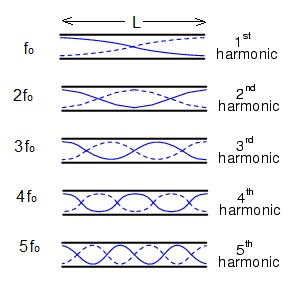Practical: Speed of sound (drinking straw)
Introduction
In this practical the speed of sound will be measured by analysing the standing wave in a drinking straw using a computer program called Audacity. This can be downloaded free from sourceforge. If you don't have Audacity on your computer download and install it then make sure it works by recording a sound either using your computers in-built microphone or a headset.

Theory
When the air in an open pipe is excited by blowing standing waves are set up in the pipe, the condition for a standing wave in an open pipe is that there must be anti-nodes at each end, this results in certain allowed frequencies called harmonics as illustrated below.

By using the frequency analysis options in Audacity it is possible to measure the frequency of the 1st harmonic, then knowing that this has a wavelength of 2L the velocity of sound can be determined using the formula v = fλ.
Method
To get the straw to make a sound blow across it's end, the sound won't be very loud but it should be something like this. Not very musical but good enough to analyse. Once recorded you can analyse the sound by selecting "plot spectrum" in the analyse menu. This will open a window like the one below.

The obvious peaks are the different harmonics of the pipe. You might naturally think that the lowest frequency peak is the first harmonic but it isn't, this is because the the flow of air across the pipe was such that the higher harmonics were excited more than the lower ones, in your recording it might be different. To identify each harmonic record the frequency of each peak (this is done by putting the cursor close to a peak and reading the figures below the graph). All harmonics should be multiples of the 1st harmonic frequency (fo) so the difference between each should be equal to fo.
Use your data to find the velocity of sound.
By measuring the fundamental frequency for different lengths of pipe (cut it) plot a graph of f vs 1/λ and determine the velocity of sound from the gradient.
